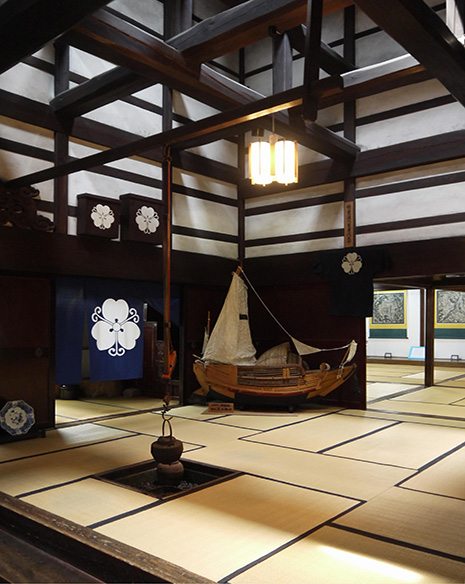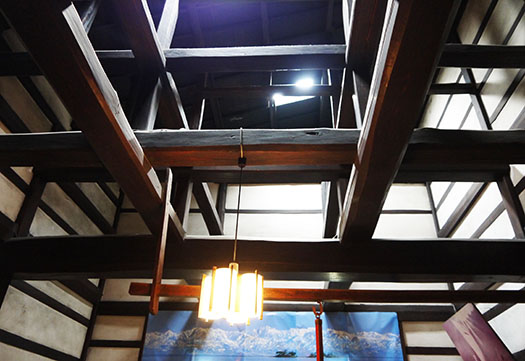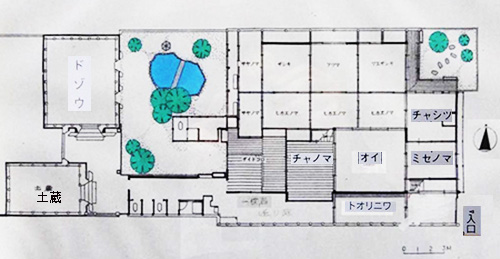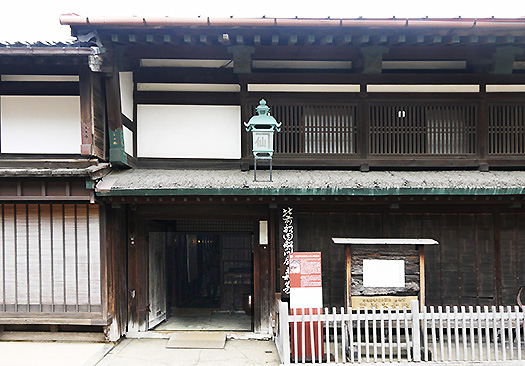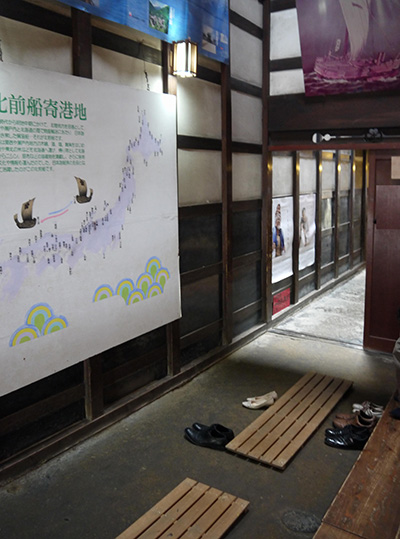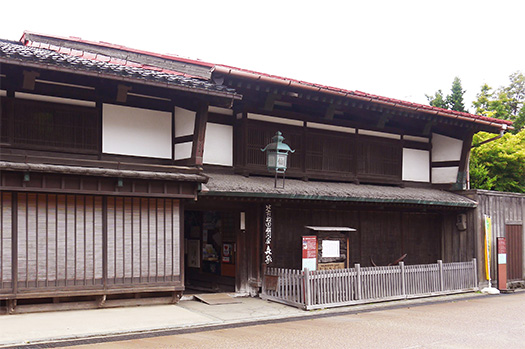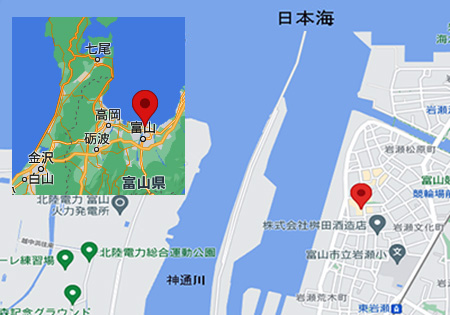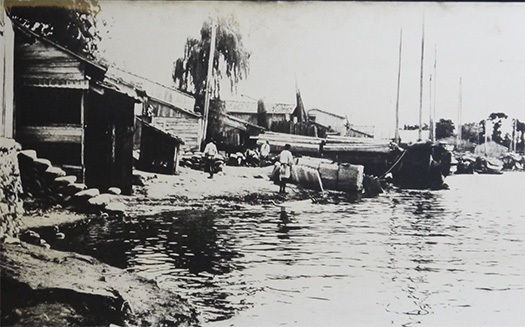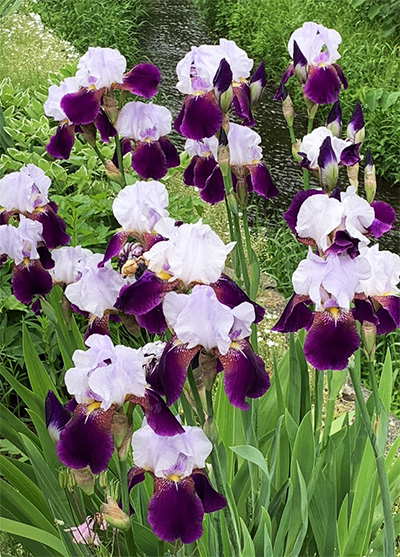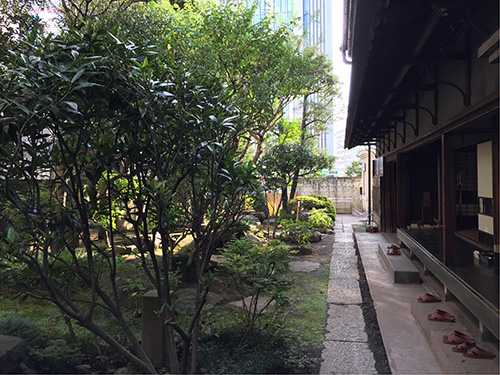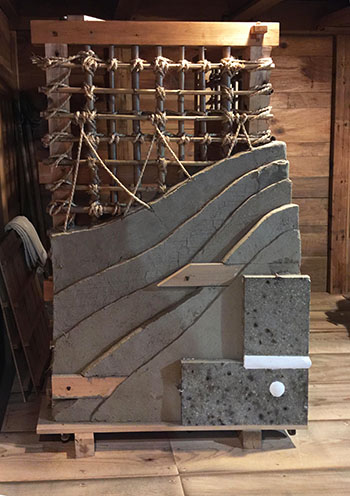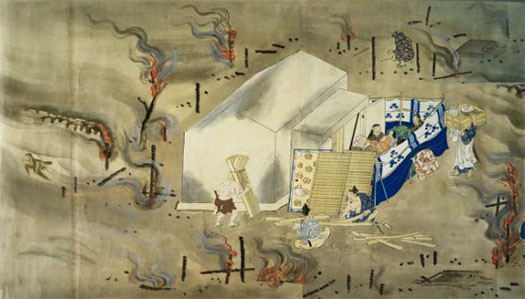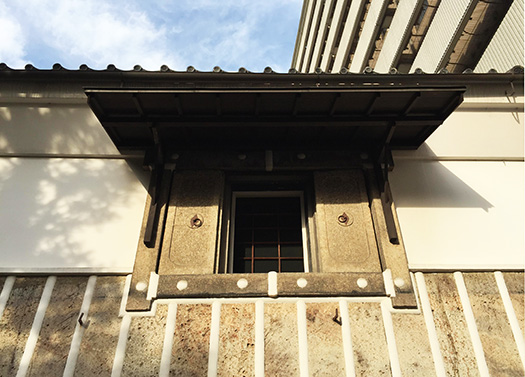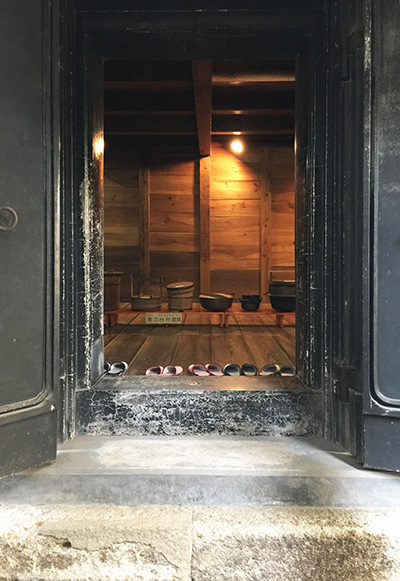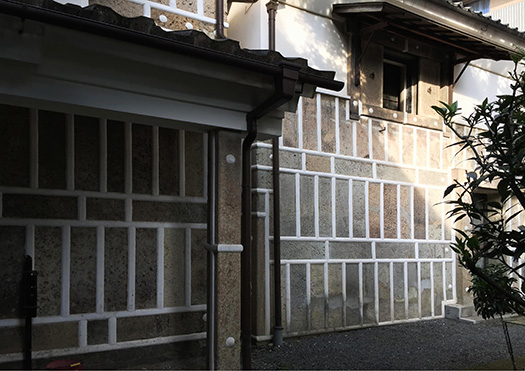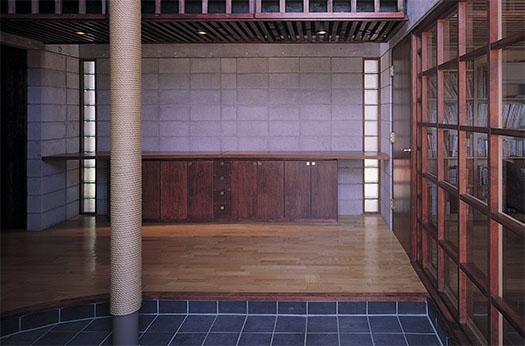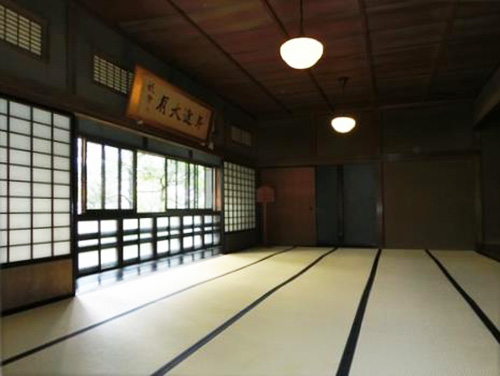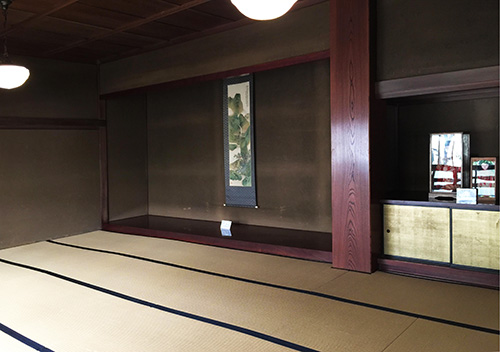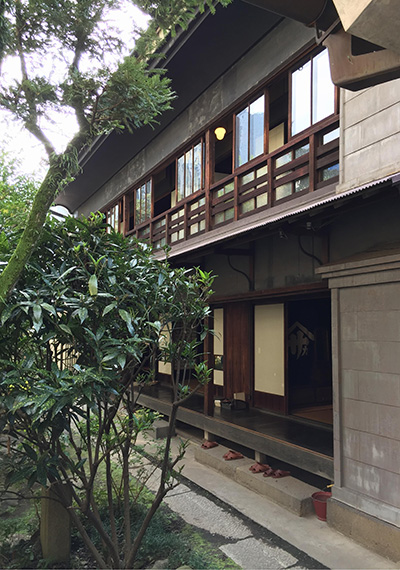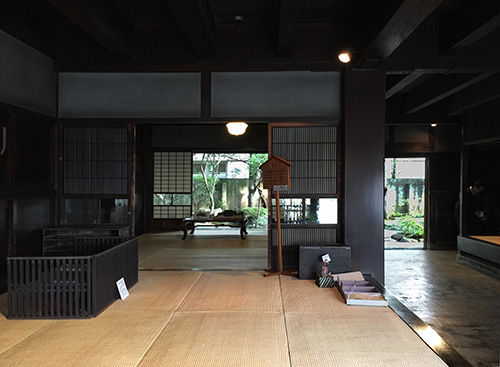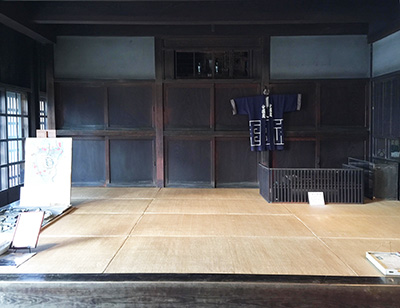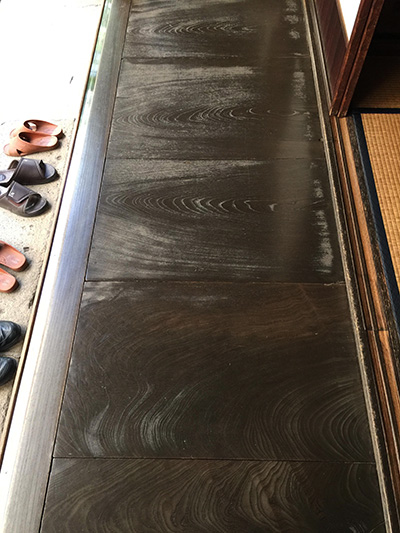
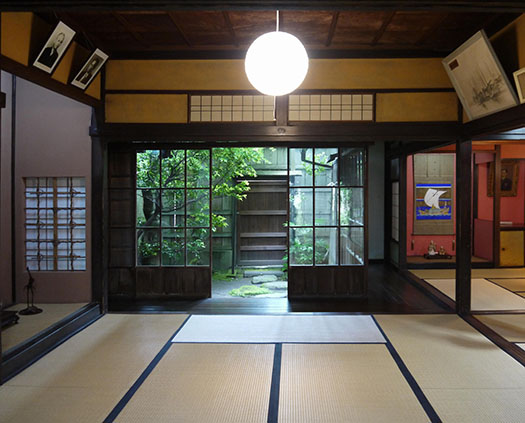
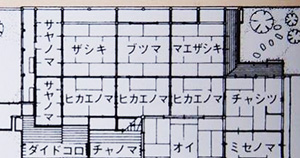

富山の廻船問屋・森家のストーリーその4。
きのう見た「オイ」と呼ばれる最重要空間・商談室の奥には
座敷が各前室(ヒカエノマ)を含め3間あって、それぞれ床の間が付設される。
いちばん上の写真は「マエザシキ」から座敷が連続している様子。
奥の「ザシキ」は「サヤノマ」を介して中庭に面している。
通常は奥の座敷は主人夫婦が使用していた空間とされていた。
そうであれば、手前側の2間は来客時の客間として機能したか。
写真は反転して「マエザシキ」から前庭と「チャシツ」を望む。
これらの座敷合計では床の間を含めて56畳・28坪の広大な空間。
展示されている現在ではこの写真のように襖が取り払われて
広大な1室空間が広がっています。
高い吹き抜けが特徴の商談空間と好対照な広がり方向での開放感の実現。
茶室は8畳で赤くベンガラで彩られた床の間の壁が特徴的。
気をつけてみるとこれだけの大空間で柱は広間中に5本だけで、
あとは床柱と連続する構造壁が目に入ってくるのみ。
水平方向への開放感がハンパなく実現されている。
天井が張られているので小屋裏でどのような「構造」があるか不明ですが、
たぶん吹き抜け部分と同様の井形の強固な木組みがあって、
こうした水平的開放空間が実現しているのではないか。
そしてまた、これだけの大空間に対して前庭と中庭への開口部から
ほどよい採光と通風を実現している。
このあたりはやはり京都が育んだ大型木造建築由来の作法なのでしょうか。
この家の大工棟梁は京都で東本願寺を手掛けた名工に依頼したと言うこと。
この家の紹介文には出てこないが、伊藤平左衛門 (9世)という名前が浮かんでくる。
事跡を見ると現代の大物建築家にも相応する建築業績の人物。
1896年より帝室技芸員。藍綬褒章受章者。
考えてみると現代ではこうした作り手の選択方法というのは廃れ気味。
日本は職人仕事へ尊敬の念がなくなった、建築に求める文化性の中身が変わった?
いや、IT事業家オラクルの会長さんがカリフォルニアで数寄屋を建てたように
むしろこういう木造建築文化性は世界の方が認識しつつあるのではないか。
京都での木造建築の歴史伝統という建築文化パワーが明治には存在した。
建築主側からみて「一流の・・・」選択としてあったのだろう。
たしかにこの広間の広大さといい、商談空間の豪放な作りようといい、
宗教建築の大型木造の作法のようなものがあるのかもと思える。
現代で言えばやはり著名建築家と全国ゼネコンみたいな取り合わせが相応か。
タテ方向で大きな吹き抜けを作り平面で大広間をこの住宅サイズで実現するなど
住宅規模の建築趣向ではなくより大型の宗教建築で確立した流儀。
その規範として納得できる作り手選択だったといえるのでしょう。
ビジネス建築なので「東本願寺の・・・」という口上に効果があったかとも思える。
ひるがえって現代では民間住宅の領域に限って言えば
こういった部分の民の「選択基準」というものは不明化している。
極端に言えばハウスメーカーの「有名さ」とかが刷り込み誤解としてあったりする。
ふつうに考えれば著名建築家の関与といったことが相当しているか?
いわば「一流の」という概念がそれに当たるのだろうけれど、
現代ではそういう価値感はこと住宅の領域ではあいまい化。
「良き建築、良き住宅」という価値感がかつては実感として存在していたものが、
現代日本社会では大きく揺らいできていると言える。
大きなテーマなのでうかつに結論づけはできない。
少なくとも、この建物の創建時期・明治初年にはこういう基準が明確だった。
この住宅でのひとつの気付きだと思えます。
English version⬇
[A large hall with a total of 56 tatami mats / A nice Japanese house ㉞-4]
Story 4 of Toyama’s shipping wholesaler, Mori family.
In the back of the most important space, the business meeting room, called “Oi” that I saw yesterday
There are 3 tatami rooms including each front room (Hikaenoma), and each has an alcove.
The top photo shows a series of tatami rooms from “Maezashiki”.
“Zashiki” in the back faces the courtyard via “Sayanoma”.
Normally, the tatami room in the back was the space used by the husband and wife.
If so, did the two rooms on the front side function as guest rooms for visitors?
The photo is flipped over and the front yard and “Chashitsu” are seen from “Maezashiki”.
The total of these tatami mats is a vast space of 56 tatami mats and 28 tsubo including the alcove.
Now that it is on display, the sliding doors have been removed as shown in this photo.
A vast one-room space is spreading.
Realization of a feeling of openness in the direction of expansion, which contrasts well with the business negotiation space, which is characterized by a high atrium.
The tea room is 8 tatami mats and features a wall between the alcove colored in red Bengala.
Be careful, there are only 5 pillars in the hall in such a large space.
All that is left is to see the structural wall that is continuous with the floor pillars.
A feeling of openness in the horizontal direction is realized without hampering.
Since the ceiling is stretched, it is unknown what kind of “structure” there is in the back of the hut,
Maybe there is a strong Igata woodwork similar to the atrium,
Isn’t such a horizontal open space realized?
And again, from the opening to the front yard and the courtyard for such a large space
Achieves moderate lighting and ventilation.
Is this a method derived from the large wooden construction that Kyoto nurtured?
It is said that the carpenter builder of this house asked a master craftsman who worked on Higashi Honganji in Kyoto.
Although it does not appear in the introductory text of this house, the name Ito Heizaemon (9th generation) comes to mind.
Looking at the facts, he is a person with architectural achievements that is suitable for a modern big-name architect.
When you think about it, these methods of selecting creators are becoming obsolete in modern times.
Japan has lost respect for craftsmanship, has the cultural content required for architecture changed?
No, like the chairman of IT entrepreneur Oracle built a sukiya in California
Rather, the world is recognizing this kind of wooden building culture.
The architectural cultural power of the historical tradition of wooden architecture in Kyoto existed in the Meiji era.
From the builder’s point of view, it must have been a “first-class …” choice.
It’s true that this hall is vast, and it’s good to create a business negotiation space.
It seems that there is something like a large wooden manner of religious architecture.
In modern times, is it appropriate to have a combination of a well-known architect and a national general contractor?
Create a large atrium in the vertical direction, realize a large hall with this house size, etc.
A style established with larger religious buildings rather than residential-scale architectural tastes.
It can be said that it was a maker’s choice that was convincing as the norm.
Since it is a business architecture, it seems that it was effective in saying “Higashi Honganji …”.
On the contrary, in modern times, speaking only in the area of private housing
The “selection criteria” of these people are unclear.
In the extreme, the “famousness” of the house maker is imprinted and misunderstood.
Is it equivalent to the involvement of a well-known architect in general?
So to speak, the concept of “first-class” corresponds to that, but
In modern times, such a sense of value is ambiguous in the area of housing.
The value of “good architecture, good housing” used to exist as a real feeling.
It can be said that it has been greatly shaken in modern Japanese society.
It’s a big theme, so I can’t conclude.
At least, these standards were clear at the time of construction of this building, the first year of the Meiji era.
I think this is one of the things I noticed in this house.
Posted on 6月 16th, 2021 by 三木 奎吾
Filed under: 住宅マーケティング, 日本社会・文化研究 | No Comments »


